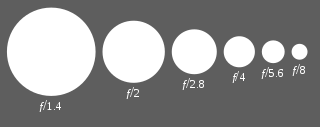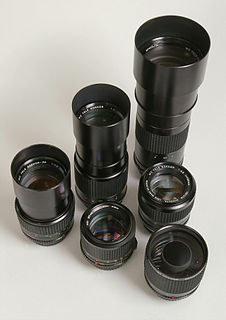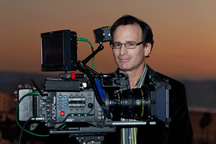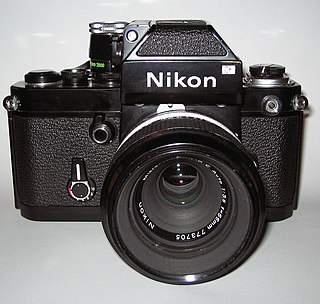Related Research Articles

Photography is the art, application and practice of creating durable images by recording light or other electromagnetic radiation, either electronically by means of an image sensor, or chemically by means of a light-sensitive material such as photographic film. It is employed in many fields of science, manufacturing, and business, as well as its more direct uses for art, film and video production, recreational purposes, hobby, and mass communication.

35 mm film (millimeter) is the film gauge most commonly used for motion pictures and chemical still photography. The name of the gauge refers to the width of the photographic film, which consists of strips 34.98 ± 0.03 mm (1.377 ± 0.001 inches) wide. The standard negative pulldown for movies is four perforations per frame along both edges, which results in 16 frames per foot of film. For still photography, the standard frame has eight perforations on each side.

A camera is an optical instrument to capture still images or to record moving images, which are stored in a physical medium such as in a digital system or on photographic film. A camera consists of a lens which focuses light from the scene, and a camera body which holds the image capture mechanism.

A rangefinder camera is a camera fitted with a rangefinder, typically a split-image rangefinder: a range-finding focusing mechanism allowing the photographer to measure the subject distance and take photographs that are in sharp focus. Most varieties of rangefinder show two images of the same subject, one of which moves when a calibrated wheel is turned; when the two images coincide and fuse into one, the distance can be read off the wheel. Older, non-coupled rangefinder cameras display the focusing distance and require the photographer to transfer the value to the lens focus ring; cameras without built-in rangefinders could have an external rangefinder fitted into the accessory shoe. Earlier cameras of this type had separate viewfinder and rangefinder windows; later the rangefinder was incorporated into the viewfinder. More modern designs have rangefinders coupled to the focusing mechanism, so that the lens is focused correctly when the rangefinder images fuse; compare with the focusing screen in non-autofocus SLRs.

A press camera is a medium or large format view camera that was predominantly used by press photographers in the early to mid-20th century. It was largely replaced for press photography by 35mm film cameras in the 1960s, and subsequently, by digital cameras. The quintessential press camera was the Speed Graphic. Press cameras are still used as portable and rugged view cameras.

The f-number of an optical system is the ratio of the system's focal length to the diameter of the entrance pupil. It is a dimensionless number that is a quantitative measure of lens speed, and an important concept in photography. It is also known as the focal ratio, f-ratio, or f-stop. It is the reciprocal of the relative aperture. The f-number is commonly indicated using a hooked f with the format f/N, where N is the f-number.

The Brownie was a long-running popular series of simple and inexpensive cameras made by Eastman Kodak. Introduced in 1900, it introduced the snapshot to the masses. It was a basic cardboard box camera with a simple meniscus lens that took 2 1/4-inch square pictures on 117 roll film. It was conceived and marketed for sales of Kodak roll films. Because of its simple controls and initial price of $1 along with the low price of Kodak roll film and processing, The Brownie camera surpassed its marketing goal.

In photography and cinematography, a telephoto lens is a specific type of a long-focus lens in which the physical length of the lens is shorter than the focal length. This is achieved by incorporating a special lens group known as a telephoto group that extends the light path to create a long-focus lens in a much shorter overall design. The angle of view and other effects of long-focus lenses are the same for telephoto lenses of the same specified focal length. Long-focal-length lenses are often informally referred to as telephoto lenses although this is technically incorrect: a telephoto lens specifically incorporates the telephoto group.

The movie camera, film camera or cine-camera is a type of photographic camera which takes a rapid sequence of photographs on an image sensor or on a film. In contrast to a still camera, which captures a single snapshot at a time, the movie camera takes a series of images; each image constitutes a "frame". This is accomplished through an intermittent mechanism. The frames are later played back in a movie projector at a specific speed, called the frame rate. While viewing at a particular frame rate, a person's eyes and brain merge the separate pictures to create the illusion of motion.

Large format refers to any imaging format of 4×5 inches (102×127 mm) or larger. Large format is larger than "medium format", the 6×6 cm or 6×9 cm size of Hasselblad, Rollei, Kowa, and Pentax cameras, and much larger than the 24×36 mm (0.95×1.42 inch) frame of 35 mm format. The main advantage of large format, film or digital, is a higher resolution at the same pixel pitch, or the same resolution with larger pixels or grains. A 4×5 inch image has about 15 times the area, and thus 15× the total resolution, of a 35 mm frame.
Panoramic photography is a technique of photography, using specialized equipment or software, that captures images with horizontally elongated fields of view. It is sometimes known as wide format photography. The term has also been applied to a photograph that is cropped to a relatively wide aspect ratio, like the familiar letterbox format in wide-screen video.

Instant film is a type of photographic film introduced by Polaroid to be used in an instant camera. The film contains the chemicals needed for developing and fixing the photograph, and the instant camera exposes and initiates the developing process after a photo has been taken.

In photography, a tripod is used to stabilize and elevate a camera, a flash unit, or other photographic equipment. All photographic tripods have three legs and a mounting head to couple with a camera. The mounting head usually includes a thumbscrew that mates to a female threaded receptacle on the camera, as well as a mechanism to be able to rotate and tilt the camera when it is mounted on the tripod. Tripod legs are usually made to telescope, in order to save space when not in use. Tripods are usually made from aluminum, carbon fiber, steel, wood or plastic.
JA Prestwich Industries, was an English manufacturing company named after founder John Alfred Prestwich, which was formed in 1951 by the amalgamation of J.A.Prestwich and Company Limited and Pencils Ltd.

The Nikon F2 is a professional level, interchangeable lens, 35 mm film, single-lens reflex (SLR) camera. It was manufactured by the Japanese optics company Nippon Kogaku K. K. in Japan from September 1971 to 1980. It used a horizontal-travel focal plane shutter with titanium shutter curtains and a speed range of 1 to 1/2000 second plus Bulb and Time, and flash X-sync of 1/80th second. It had dimensions of 98 mm height, 152.5 mm width, 65 mm depth and 730 g weight. It was available in two colors: black with chrome trim and all black.
In photography, a long-focus lens is a camera lens which has a focal length that is longer than the diagonal measure of the film or sensor that receives its image. It is used to make distant objects appear magnified with magnification increasing as longer focal length lenses are used. A long-focus lens is one of three basic photographic lens types classified by relative focal length, the other two being a normal lens and a wide-angle lens. As with other types of camera lenses, the focal length is usually expressed in a millimeter value written on the lens, for example: a 500 mm lens. The most common type of long-focus lens is the telephoto lens, which incorporate a special lens group known as a telephoto group to make the physical length of the lens shorter than the focal length.

The Sony Cyber-shot DSC-RX100 is a 20.2 megapixel compact camera, part of the Cyber-shot line of digital cameras made by Sony and announced on 6 June 2012. It was named as the "European Advanced Compact Camera for 2012–2013" by the European Imaging and Sound Association (EISA) and one of the 'Best Inventions of 2012' by TIME.

The 35 mm format, or simply 35 mm, is the common name for the 36×24 mm film format or image sensor format used in photography. It has an aspect ratio of 3:2, and a diagonal measurement of approximately 43 mm. It has been employed in countless photographic applications including single-lens reflex (SLR) cameras, rangefinder cameras, mirrorless interchangeable-lens digital cameras, digital SLRs, point-and-shoot film cameras, and disposable film cameras.
Carl Louis Gregory was an American cinematographer.
References
- Coe, Brian. The History of Movie Photography; Eastview Editions, 1981
- Gregory, Carl Louis. "The Early History of Wide Films: Being a Peek into the Past that is Both Interesting and Enlightening" published in American Cinematographer (January, 1930)
- Toulmin, Vanessa et al. (eds.), The Lost World of Mitchell and Kenyon: Edwardian Britain on Film, London, British Film Institute (2004).
| This film technology article is a stub. You can help Wikipedia by expanding it. |